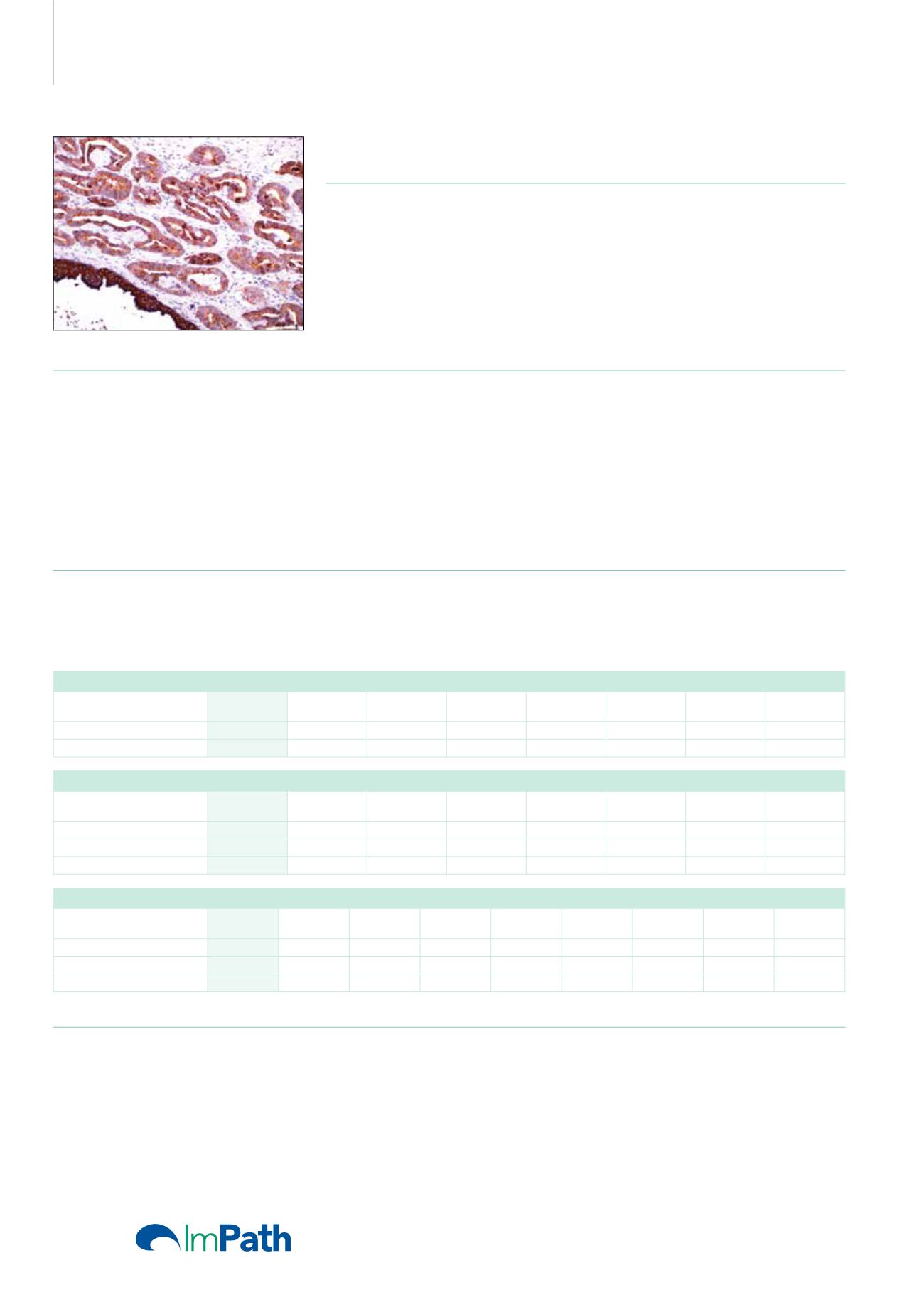
Antibodies for
Immunohistochemistry
PSAP (PASE/4LJ)
Mouse Monoclonal Antibody
Cat. No. Description
Volume
45255 IMPATH PSAP RTU M (PASE/4LJ)
50 Tests
44379 PSAP RTU M (PASE/4LJ)
7 ml Ready To Use
44777 PSAP 0,1 M (PASE/4LJ)
100 µl liquid Concentrated
44778 PSAP 1 M (PASE/4LJ)
1 ml liquid Concentrated
Product Specifications
Designation
IVD
Reactivity
Paraffin
Visualization
Cytoplasmic
Control
Prostate
Stability
Up to 36 mo. at 2-8°C
Isotype
IgG
1
Manual Protocol*
• Pretreatment: Heat Induced Epitope
Retrieval (HIER)
• Primary Antibody Incubation Time:
10-30min @ 25-37°C
• 2-step polymer detection
*Please refer to product insert for complete protocol.
ImPath Protocol*
• Dewax: Dewax Solution 2 (DS2)
• Pretreatment: Retrieval Solution pH 9.0
(TR1) 32min @ 98-103°C
• Primary Antibody Incubation Time:
10-90min @ 25-37°C
• HRP Polymer (Universal) or AP Polymer
(Universal) for 12 min
*Please refer to product insert for complete protocol.
Product Description
Anti-PSAP reacts with prostatic acid phosphatase in the glandular epithelium of normal and hyperplastic prostate, carcinoma of the prostate,
and metastatic cells of prostatic carcinoma. This marker may be helpful in pinpointing the site of origin in cases of metastatic carcinoma of the
prostate, and is considered a more sensitive marker than PSA. However, it also offers less specificity. Nevertheless, PSAP complements PSA in
the right clinical context.
Prostate: Malignant vs. Benign
PSAP
PSA
Androgen
Receptor
P504s
CK, 34βE12
p63
CK 5
CK 14
Prostate Carcinoma
+
+
+
+
-
-
-
-
Benign Prostate
+
+
+
-/+
+
+
+
+
Carcinoma: Differential Diagnosis
PSAP
Androgen
Receptor
BCA-225 GCDFP-15
ER/PR Mamma-
globin
PSA
CD44
Salivary Duct Carcinoma
-
+
+
+
-
-
-
-
Breast Carcinoma
-
+(apocrine)
+
+
+/-
+
-
-
Prostate Carcinoma
+
+
-
-
-
-
+
+
Prostate Lesions
PSAP
PSA
P504s CK, 34βE12 p63
CK 7 Thrombo-
modulin Uroplakin III
PAX-2
Prostate Carcinoma
+
+
+
-
-
-
-
-
-
Urothelial Carcinoma
-
-
-
+
+
+
+
+
-
Nephrogenic Adenoma
-
-
+
+/-
-
+
-
-
+
Reference
1. Ansari MA, et al. Am J Clin Path. 1981; 76:94-98.
2. Nadji M, Morales AR. Ann NY Acad Sci. 1982; 390:133-141.
3. Kimura N, et al. Virchows Arch A. 1986; 4:247-251.
4. Kidwai N, et al. Breast Cancer Res. 2004; 6(1):R18-23.
5. Kuroda N, et al. Pathol Int. 1999 May; 4 9(5):457-61.
6. Elgamal AA, et al. Urology. 1994 Jul; 44(1):84-90.
7. Gatalica Z, et al. Appl Immunohistochem Mol Morphol. 2000 Jun; 8(2):158-61.
210


